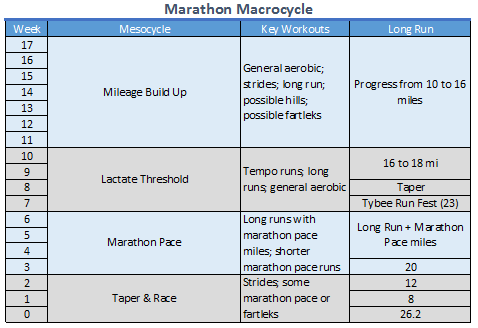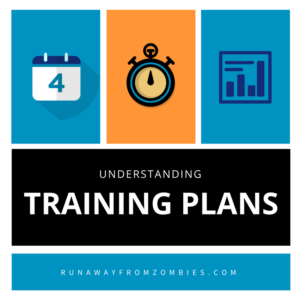In the last two weeks you’ve learned the concepts of periodization and pace zones. Now let’s look at them within training plans. I’ll walk you through how I wrote a training plan for my spring marathon to show you how the two concepts work together. Even if you’re not writing plans for your races from scratch, you can use these concepts to effectively modify free cookie-cutter plans.

Writing Plans: Marathon Training
Step 1: Determining the Macrocycle
We learned about macro, meso, and microcycles in training periodization. You can read about it here.
I finished my last macrocycle two weeks after I ran the Savannah Rock n Roll Half Marathon. I’m running the Skidaway Marathon on March 24th attempting a personal record (current personal record: 4:16:15).
This determines a macrocycle or training season of 18 weeks – November 20-March 24.
Step 2: Determining Mesocycles
Some mesocycles are obligatory. For example, the last three weeks will be my taper and race. That’s one mesocycle, leaving 15 weeks.
A successful marathon is typically run two to three percent slower than lactate threshold pace, so if I increase this threshold, I can run faster, for longer, more comfortably in the marathon. I will spend one mesocycle on improving my lactate threshold.
Since I plan to run a steady pace throughout my marathon, I will devote another mesocycle to practicing marathon race pace in both my medium runs and my long runs. I want to know that pace in my legs, lungs, heart, and even arm swing. Since this is more race-specific, I will place this mesocycle after lactate threshold improvement, closer to the taper and race.
I won’t devote any weeks to anaerobic zone training. Seeing as most of marathon training is aerobic, any time practicing super fast paces would be better spent improving my aerobic endurance. You can read about these pace zones here.

Determining Mesocycle Length
When you first try out a new workout, you will be clumsy – logistically and bodily. Over the next two or three weeks, your body will improve and adapt to the new stressor until you get diminishing returns. By moving on to the next mesocycle and new stressor, you prevent plateauing.
I chose 4 week mesocycles for lactate threshold improvement and marathon goal pace practice – three weeks of increased intensity and duration and a fourth week of fewer miles/recovery.
Mileage Base Mesocycle
The remaining 7 weeks will be a mesocycle of building up aerobic endurance and mileage. I will be running general aerobic runs, easy recovery runs, and adding strides. I will build up my long runs and overall weekly mileage.
In the latter weeks, I might include fartleks or hill running to build strength and improve running form. Two of the weeks will have fewer miles so my body can adapt and recover from the new training stimulus.
Step 3: Determining Microcycles
Due to the long-ass long runs which I only have time for on the weekends, my microcycle is anchored in 1 week increments.
To determine the content of my first microcycles, I look to my current training. I run 5 days a week with three harder workouts and two recovery runs, clocking in at 40 miles per week. I will build mileage, but keep my same number of running days, ratio of hard to easy, and spread out my miles according to workout purpose.

Long Runs
Long runs are important to marathon training. It’s where you get to practice being on your feet for 2+ hours. It teaches your body how to handle glycogen storage and use. Long runs encourage the adaptations your body needs to run 26.2 miles.
Start by pinning down the long runs you know, including your first long run (close to what you’re currently running), your last long run (the race – 26.2 miles), the taper long runs (typically 12 mi and 8 mi), and any key long runs.
My key long runs are 20 miles, 3 long runs that include marathon goal pace miles (one of my mesocycles), and a secondary race weekend (23 miles).
From there, you fill in the remaining long runs, building conservatively but progressively with shorter runs for recovery weeks.
Supplementary Work
When you’re writing plans, don’t forget to add in strength, mobility, and flexibility work to complement your running. Also consider any cross-training, such as deep water running, cycling, or swimming.

Best Laid Plans
When I’m writing plans, I consider them an outline or a guideline. It has the key milestones I’d like to hit and a general road map to get there. Then, I carefully watch my progress and make changes as needed. By the end, my training may look vastly different from my first plan.
You must balance challenging yourself and progressing logically from where you are, but by understanding periodization and training zones, you will be better equipped to take training into your own hands.

Share on Social Media!





Everything is very open with a really clear explanation of the challenges. It was truly informative. Your website is useful. Many thanks for sharing.